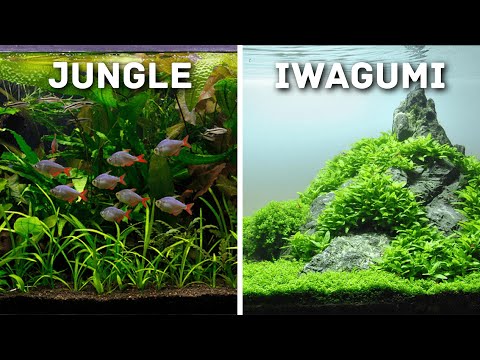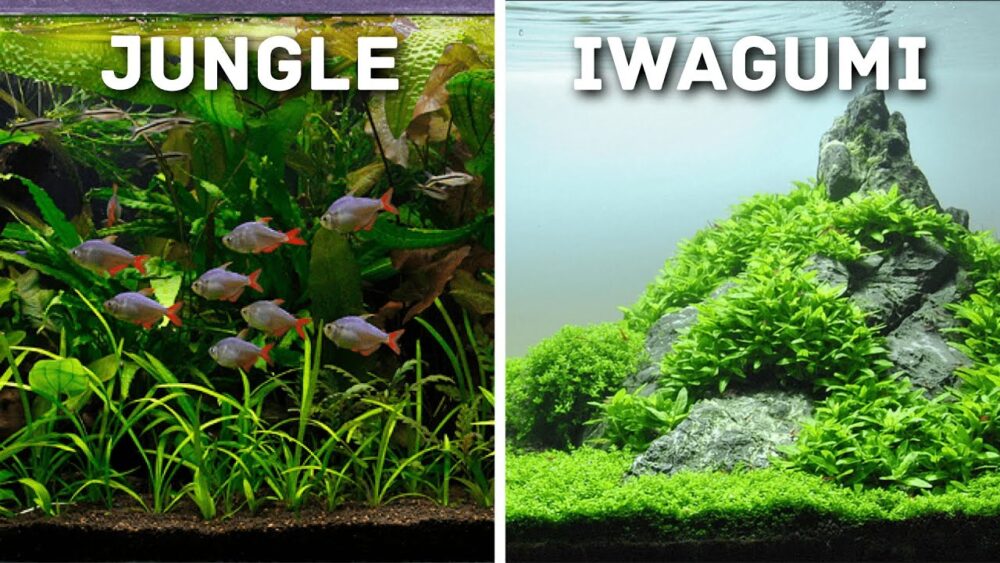Aquascaping aquarium ideas are a captivating way to transform your fish tank into an awe-inspiring underwater masterpiece. With a perfect blend of art and nature, these innovative designs showcase a harmonious balance of aquatic plants, rocks, and unique ornaments. Dive into a world where creativity knows no bounds, and unleash your imagination to create a mesmerizing aquatic paradise. From lush green forests to serene underwater landscapes, the possibilities are endless. Discover the art of aquatic gardening as you experiment with different plant species, textures, and colors to achieve a stunning visual impact. Delight in the tranquility that these aquascapes offer, as they create a peaceful and serene environment for your aquatic companions. Whether you’re a seasoned aquarist or a beginner, aquascaping provides a rewarding experience that will captivate both you and your fish. So, why settle for a plain fish tank when you can immerse yourself in the world of aquatic wonders? Let your creativity flow and transform your aquarium into a captivating masterpiece that will leave everyone in awe. Explore the enchanting world of aquascaping, and bring your underwater dreams to life.

2023 Must-Try Aquascaping Styles for Your Planted Aquarium (Trending)
| Style | Description | Key Features |
|---|---|---|
| Nature Aquarium | The Nature Aquarium style, pioneered by Takashi Amano, emulates natural landscapes. It focuses on creating a lush, vibrant underwater ecosystem resembling a slice of nature. | Use of driftwood, rocks, and diverse plant species; careful placement to create depth and balance; natural-looking hardscape elements. |
| Dutch Style | The Dutch Style emphasizes meticulously arranged and colorful plant layouts, resembling a well-maintained garden. It relies on the vibrant growth and contrast of various aquatic plants. | Strong emphasis on plant variety and colors; symmetrical and geometric arrangements; regular pruning and maintenance to maintain shape and balance. |
| Iwagumi Style | The Iwagumi Style, originating from Japan, showcases simplicity and harmony through minimalistic design. It typically utilizes a limited number of rocks and carpeting plants. | One or few main stones arranged in specific formations; carefully selected foreground carpeting plants; symmetrical and minimalist approach. |
| Biotope Aquascape | The Biotope Aquascape recreates natural habitats found in specific regions around the world, aiming to replicate a slice of nature as accurately as possible. | Research-based selection of plants, fish, and decor from specific biomes; replication of natural water parameters and conditions; attention to detail for an authentic representation. |
| Wabi-Kusa | Wabi-Kusa is a unique style that combines elements of aquascaping and traditional Japanese gardening. It involves arranging aquatic plants in a self-contained, soil-based ecosystem. | Plants grown in specialized soil balls or mats; incorporation of decorative elements like stones or driftwood; low-maintenance and self-sustaining setup. |
“Dive into the Enchanting World of Aquascaping Styles for Your Planted Aquarium!”
Aquascaping Aquarium Ideas: Creating an Underwater Oasis
Aquascaping is an art form that combines creativity, design, and a love for aquatic life. It involves arranging plants, rocks, driftwood, and other elements to create a visually stunning aquarium. If you are looking for inspiration to transform your aquarium into a breathtaking underwater oasis, here are five compelling aquascaping ideas to consider.
Nature-inspired Aquascape: Bringing the Outdoors Indoors
If you are a nature lover, a nature-inspired aquascape can be an excellent choice. This style aims to replicate a natural landscape, such as a forest or a riverbank, within your aquarium. The key is to use plants and decorations that mimic the elements found in these environments.
Start by selecting a variety of plants with different heights, shapes, and colors. Foreground plants like dwarf hairgrass can mimic grassy meadows, while taller plants like Amazon swords can resemble trees. Add rocks and driftwood to create hiding spots and mimic the look of fallen logs or rocky outcrops.
Consider adding fish species that are native to the environment you are trying to recreate. For example, if you are going for a jungle theme, you could include cardinal tetras or dwarf cichlids.
Minimalistic Aquascape: Beauty in Simplicity
Less is often more, and this philosophy holds true in the world of aquascaping. A minimalistic aquascape focuses on simplicity, clean lines, and negative space. It emphasizes a few carefully chosen elements rather than an abundance of plants and decorations.
When designing a minimalistic aquascape, choose plants with small leaves and compact growth habits. Consider using carpeting plants like Monte Carlo or dwarf baby tears to create a lush green carpet effect. Arrange a couple of strategically placed rocks or driftwood pieces to provide focal points without overwhelming the space.
Remember to choose fish and other aquatic creatures that complement the minimalistic aesthetic. Nano fish species like celestial pearl danios or ember tetras can be great choices.
Dutch Aquascape: A Burst of Color and Variety
If you prefer a vibrant and colorful aquascape, the Dutch style might be perfect for you. Originating in the Netherlands, this style focuses on lush plant growth and a diverse range of species. The goal is to create a visually striking display with a harmonious blend of colors, textures, and shapes.
When creating a Dutch aquascape, use a variety of plants with different leaf colors, sizes, and shapes. Arrange them in layers, with taller plants in the back and shorter ones in the front. Consider using a mix of green, red, and purple plants to achieve a captivating color palette.
To enhance the visual appeal, add rocks or driftwood as accent pieces. Avoid overcrowding the aquarium to allow each plant to stand out. Popular fish choices for Dutch aquascapes include rainbowfish, guppies, and tetras.
Iwagumi Aquascape: Zen-like Simplicity
The Iwagumi style, influenced by Japanese Zen gardens, embraces simplicity, balance, and a serene atmosphere. It typically features a minimal number of plant species and relies heavily on the arrangement of rocks to create a sense of calm and tranquility.
When designing an Iwagumi aquascape, choose a few select plant species such as dwarf hairgrass or java moss. Use rocks as the focal point and arrange them in a way that creates a sense of harmony and balance. The key is to create a visual journey that guides the viewer’s eye across the aquarium.
Consider introducing fish that are known for their grace and peaceful nature, such as neon tetras or cherry barbs. These species will complement the overall serenity of the Iwagumi aquascape.
Biotope Aquascape: Recreating Natural Habitats
If you are passionate about conservation and preserving natural habitats, a biotope aquascape is a great option. This style aims to recreate specific ecosystems found in nature, such as a river, lake, or coral reef.
Research the specific biotope you want to recreate and select plants, rocks, and fish that are native to that region. Pay attention to the water parameters required by those species to ensure their health and well-being.
Decorate the aquarium with elements that mimic the natural environment, such as sand or gravel substrate, rocks, and driftwood. Consider adding specific plants that are characteristic of the biotope, such as Vallisneria for a river-themed aquascape or various corals for a reef-inspired setup.
In Conclusion
Aquascaping offers endless possibilities for creating stunning and unique aquariums. Whether you prefer a nature-inspired design, a minimalistic approach, a burst of color, a Zen-like simplicity, or a biotope recreation, there is an aquascape style that will suit your taste and preferences.
Remember to carefully select plants, rocks, and fish that are compatible with each other and the chosen aquascape style. With a bit of creativity and planning, you can transform your aquarium into a captivating underwater oasis that will mesmerize anyone who lays eyes on it.
Aquascaping Aquarium Ideas:
#NatureInGlass #AquaticArt
Frequently Asked Questions
What are some popular aquascaping aquarium ideas?
1. Nature Aquarium: This style aims to recreate a natural underwater scene, with a combination of different plant species, rocks, and driftwood. It often features a lush carpet of foreground plants, tall background plants, and a focal point such as a stone or driftwood arrangement.
2. Dutch Style Aquarium: This style focuses on the meticulous arrangement of different plant species in a symmetrical pattern. It often uses a variety of colors and leaf shapes to create a vibrant and eye-catching display.
3. Iwagumi Style: This style emphasizes simplicity and minimalism, using only a few carefully placed rocks and a carpet of low-growing plants to create a serene and balanced composition.
These are just a few examples, and there are many other aquascaping styles and ideas to explore based on personal preferences and creativity.
What are the key components of a successful aquascaping aquarium?
1. Substrate: Choosing the right substrate is crucial for plant growth and anchoring. A nutrient-rich substrate like aquasoil or a layer of fertilizers beneath a sand or gravel substrate can provide essential nutrients for plant growth.
2. Lighting: Proper lighting is essential for photosynthesis and healthy plant growth. LED lights specifically designed for planted aquariums are recommended, as they provide the right spectrum and intensity of light for plants.
3. Filtration: A good filtration system is important for maintaining water quality and clarity. A combination of mechanical, biological, and chemical filtration is often used to remove debris, toxins, and excess nutrients.
4. CO2 Injection: Carbon dioxide (CO2) supplementation is often necessary to promote healthy plant growth. CO2 injection systems can help maintain optimal CO2 levels in the aquarium, which is essential for photosynthesis.
5. Plant Selection: Choosing the right plants is crucial for a successful aquascape. It is important to consider the plant’s growth requirements, compatibility with other species, and desired aesthetic effect.
By paying attention to these key components and ensuring their proper balance, you can create a thriving and visually stunning aquascaping aquarium.
How can I maintain a healthy aquascaping aquarium?
1. Water Parameters: Monitor and maintain proper water parameters such as temperature, pH, and hardness. Regular water testing and appropriate adjustments are necessary to provide a stable and suitable environment for the plants and fish.
2. Water Changes: Regular partial water changes help remove accumulated toxins, excess nutrients, and maintain water quality. Aim to change about 20-30% of the water every week or as needed.
3. Pruning and Trimming: Regular pruning and trimming of plants are essential to control growth, prevent overcrowding, and maintain the desired shape and appearance of the aquascape. Remove any dead or decaying plant matter promptly.
4. Algae Control: Algae is a common challenge in aquascaping aquariums. Maintaining proper lighting duration, nutrient balance, and CO2 levels can help prevent excessive algae growth. Additionally, manual removal and the introduction of algae-eating fish or invertebrates can help keep algae in check.
5. Regular Maintenance: Regularly clean the aquarium, filter media, and equipment to prevent debris buildup and ensure optimal performance. Keep an eye out for any signs of disease or stress in the fish or plants and take appropriate action.
By following these maintenance practices and staying proactive, you can enjoy a healthy and thriving aquascaping aquarium.



